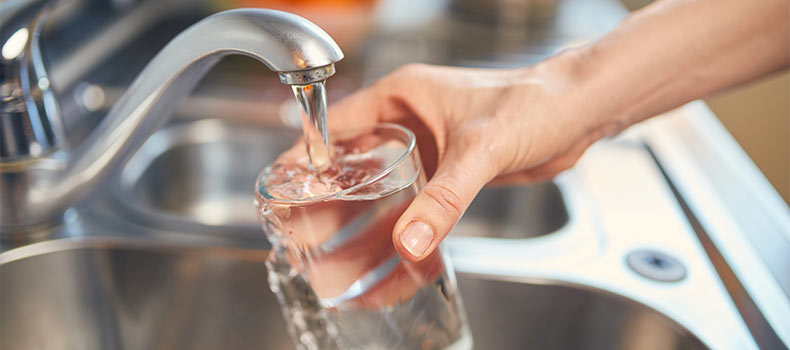
We are fortunate in that we don't usually have to worry about the quality of the drinking water in our homes. However, contamination can still occur from issues in and around your home, disasters, or the failure of treatment systems. You might not even be aware of it, since most of the common water contaminants found in our homes are colorless, tasteless, and odorless.
If you're looking to buy a new home, then that is a great time to test the quality of that home's water supply. Significant contamination may be a problem for the whole neighborhood, or it could be an issue with the home or the well itself — which might be expensive to correct. If the quality of the water is good, then you'll have peace of mind knowing that the water you're drinking is safe can clean.
Coliform Bacteria: This is the most important test to determine if the water is safe to drink. It detects contamination from sewage, surface water, and other sources that may contain disease-causing bacteria. Coliforms should never be present in drinking water. The test also includes the detection of E. coli.
Nitrates/Nitrites: Elevated levels of nitrates and nitrites are often caused by fertilizers used on farmland, lawns, golf courses, and parks, among other sources. More than 10 mg/L of Nitrates is dangerous to infants and pregnant women, causing a condition commonly known as "blue baby syndrome."
Lead: Lead is a toxic element and should not be present in drinking water at levels greater than 15 µg/L. Contamination from Lead solder is fairly common, and some older homes may even have lead pipes. Lead in paint is also a concern, especially in households where children are present.
Iron: Like hardness, Iron is not a health hazard, but can be a nuisance if high levels are present in water. Concentrations higher than 0.3 mg/L may cause staining and a bitter taste.
Turbidity: This is a measure of the clarity, or cloudiness, of your drinking water. Cloudy water is caused by a large number of particles suspended in the liquid. The World Health Organization (WHO) specifies that turbidity should be no higher than 5 NTU, and ideally below 1 NTU.
pH: The pH level is an indication of how acidic or alkaline the water is. Ideally, water should have a neutral pH of 7.0, and anywhere between 6.5 and 8.5 is acceptable.
In 1946, DuPont introduced nonstick cookware coated with Teflon. Today the family of fluorinated chemicals that sprang from Teflon includes thousands of nonstick, stain-repellent and waterproof compounds called PFAS, short for per- and poly-fluoroalkyl substances.
PFAS are used in a staggering array of consumer products and commercial applications. Decades of heavy use have resulted in contamination of water, soil and the blood of people and animals. PFAS are incredibly persistent, referred to as “forever chemicals”, never breaking down in the environment and remaining in our bodies for years.
Hundreds of everyday products are made with highly toxic fluorinated chemicals called PFAS. Very small doses of PFAS have been linked to cancer, reproductive and immune system harm, and other diseases. For decades, chemical companies covered up evidence of PFAS' health hazards.
The most notorious PFAS chemicals — PFOA, the Teflon chemical, and PFOS, an ingredient in 3M's Scotchgard — were phased out in the U.S. under pressure from the Environmental Protection Agency after revelations of their hidden hazards. For over four decades, W.L. Gore & Associates used toxic per- and polyfluoroalyl substances (PFAS) at its Cherry Hill plant in Elkton, Maryland. A punitive class action was filed on Feb. 1st 2023 - Plaintiffs allege W.L. Gore & Associates' use of PFAS chemicals at its Cherry Hill Plant in Elkton, Md., contaminated the groundwater, surface water, soil and air in surrounding areas.
If you're like us, we've never heard about PFAS until receiving a communication from the Attorneys that filed this “litigation”. We attended the Town Hall held at Cherry Hill Middle School on Feb. 7th, 2023. Not much was offered in terms of “resources for obtaining safe water for you and your family” so we've created one. Below is a link to this informative, comprehensive analysis of PFAS as it relates to groundwater contamination. We realize that a lot of this information is new, technical, confusing and is continuously developing. It looks like this issue will be around for a while - educate yourself on all the parameters surrounding PFAS. This doesn't change the fact — to determine if your water is contaminated with PFAS/PFOA, you'll need to have it tested.
We have coordinated PFAS water sampling analysis with an EPA approved laboratory. This laboratory can analyze Per- and Polyfluoroalkyl Substances (PFAS) in accordance with EPA 533 & EPA 537.1 Rev 2.0 and is on the EPA list of laboratories that meet the fifth Unregulated Contaminant Monitoring Rule (UCMR 5) laboratory approval program application and proficiency testing criteria for the methods indicated. The cost for this test is $379.
MAG Home Inspections provides water quality testing in Elkton and surrounding areas including North East, Perryville, Rising Sun, Chestertown, Centreville, Cecil County, Harford County, Kent County, and Queen Anne's County in Maryland as well as Chester County and Lancaster County in Pennsylvania. Not sure if that's you? Give us a call at (410) 398-3260 or send us an email.